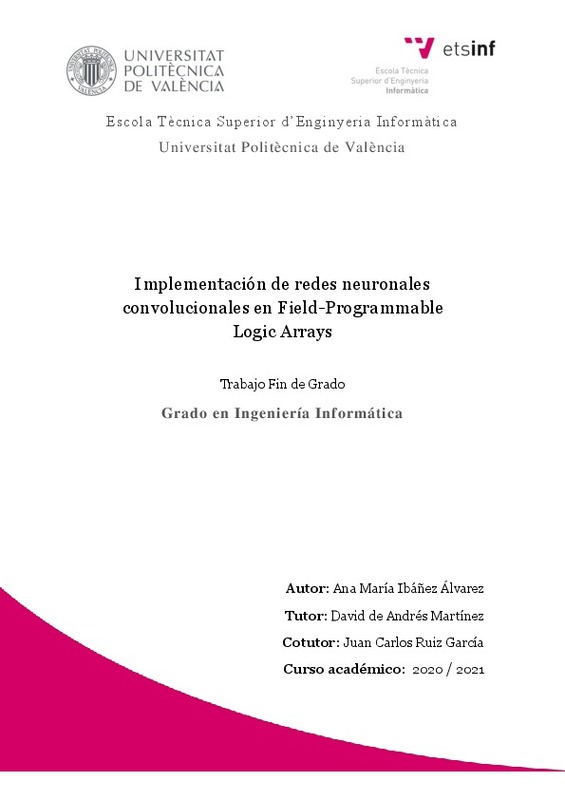JavaScript is disabled for your browser. Some features of this site may not work without it.
Buscar en RiuNet
Listar
Mi cuenta
Estadísticas
Ayuda RiuNet
Admin. UPV
Implementación de redes neuronales convolucionales en Field-Programmable Logic Arrays
Mostrar el registro sencillo del ítem
Ficheros en el ítem
| dc.contributor.advisor | Andrés Martínez, David de
|
es_ES |
| dc.contributor.advisor | Ruiz García, Juan Carlos
|
es_ES |
| dc.contributor.author | Ibáñez Álvarez, Ana María
|
es_ES |
| dc.date.accessioned | 2021-10-05T10:32:31Z | |
| dc.date.available | 2021-10-05T10:32:31Z | |
| dc.date.created | 2021-09-16 | |
| dc.date.issued | 2021-10-05 | es_ES |
| dc.identifier.uri | http://hdl.handle.net/10251/173839 | |
| dc.description.abstract | [ES] La red neuronal convolucional (CNN), es un algoritmo de aprendizaje automático que ha sido probado como un algoritmo altamente preciso y eficaz, que se ha utilizado en una gran variedad de aplicaciones tales como reconocimiento visual y clasificación de imágenes, entre otros. Las CNN de última generación tienen un elevado coste computacional, pero su naturaleza modular y su paralelismo hace que sean adecuadas para poder ser aceleradas en plataformas como las matrices de puerta programable de campo (FPGA). Por lo general, las redes neuronales convolucionales, requieren un desarrollo muy largo y complejo para poder ser implementadas o aceleradas usando FPGA, por lo tanto, en este trabajo se va a plantear usa solución para hacer esto de una forma sencilla y sin necesidad de que se tenga un conocimiento previo, ni experiencia en lenguajes de descripción de hardware (HDL). Para conseguirlo, este trabajo propone el uso de una herramienta de generación automática de VHDL; pues este tipo de herramientas, a través de código en C / C++, puede traducir automáticamente cualquier algoritmo descrito con una serie de restricciones a VHDL, inclusive la arquitectura de una red convolucional. Además, también se verán técnicas para mejorar su implementación como optimizadores y cuantificadores. Y para conseguir un mejor desarrollo, se generará un código que sea altamente optimizado, paralelo, reconfigurable, escalable y adaptable a diferentes modelos de una CNN, aunque el trabajo se centrará únicamente en un modelo. Aparte de la generación automática de código en VHDL, el trabajo también ofrecerá una pequeña introducción a las redes convolucionales, exponiendo cómo se diseñan, cómo están compuestas y cómo funcionan. Además, que mostrarán otras alternativas a las herramientas de generación automática de lenguajes de descripción de hardware, para poder acelerar una red convolucional en un acelerador hardware. | es_ES |
| dc.description.abstract | [EN] The convolutional neural network (CNN) is a machine learning algorithm that has been proven to be a highly accurate and efficient algorithm that has been used in a wide variety of applications like visual recognition or image classification, among others. State-of-the-art CNNs are highly computational, but their modular nature and parallelism make them suitable for acceleration on platforms like field programmable gate arrays (FPGAs). In general, convolutional neural networks require a very long and complex development to be implemented or accelerated using FPGA, therefore, in this project we will propose a solution to do this in a simple way and without the need for prior knowledge or experience in hardware description languages (HDL) in order to accelerate the algorithm in the FPGA. To achieve this, this project proposes the use of an automatic VHDL generation tool. This type of tool, through C / C++ code, can automatically translate any described algorithm into VHDL, including the architecture of a convolutional network. In addition, techniques to improve implementation such as optimisers and quantifiers will also be discussed. To achieve better development we will generate code that is highly optimised, parallel, reconfigurable, scalable and adaptable to different models of a CNN, although the work will focus only on one model. Apart from automatic code generation in VHDL, the paper will also give a short introduction to convolutional networks, showing how they are designed and implemented. It will also show how they are composed and how they work. In addition, it will show other alternatives to automatic hardware description language generation tools, in order to accelerate a convolutional network in a hardware accelerator. | es_ES |
| dc.format.extent | 64 | es_ES |
| dc.language | Español | es_ES |
| dc.publisher | Universitat Politècnica de València | es_ES |
| dc.rights | Reconocimiento - No comercial - Sin obra derivada (by-nc-nd) | es_ES |
| dc.subject | Redes convolucionales | es_ES |
| dc.subject | FPGA | es_ES |
| dc.subject | Paralelismo | es_ES |
| dc.subject | Capa de la red | es_ES |
| dc.subject | Convolutional networks | es_ES |
| dc.subject | Parallelism | es_ES |
| dc.subject.classification | ARQUITECTURA Y TECNOLOGIA DE COMPUTADORES | es_ES |
| dc.subject.other | Grado en Ingeniería Informática-Grau en Enginyeria Informàtica | es_ES |
| dc.title | Implementación de redes neuronales convolucionales en Field-Programmable Logic Arrays | es_ES |
| dc.type | Proyecto/Trabajo fin de carrera/grado | es_ES |
| dc.rights.accessRights | Abierto | es_ES |
| dc.contributor.affiliation | Universitat Politècnica de València. Departamento de Informática de Sistemas y Computadores - Departament d'Informàtica de Sistemes i Computadors | es_ES |
| dc.contributor.affiliation | Universitat Politècnica de València. Escola Tècnica Superior d'Enginyeria Informàtica | es_ES |
| dc.description.bibliographicCitation | Ibáñez Álvarez, AM. (2021). Implementación de redes neuronales convolucionales en Field-Programmable Logic Arrays. Universitat Politècnica de València. http://hdl.handle.net/10251/173839 | es_ES |
| dc.description.accrualMethod | TFGM | es_ES |
| dc.relation.pasarela | TFGM\142805 | es_ES |
Este ítem aparece en la(s) siguiente(s) colección(ones)
-
ETSINF - Trabajos académicos [5160]
Escola Tècnica Superior d'Enginyeria Informàtica






